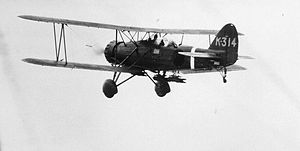Yokosuka B4Y
| B4Y1 | |
|---|---|
 |
|
| Role | Torpedo bomber |
| Manufacturer | Yokosuka |
| First flight | 1935 |
| Introduction | 1936 |
| Retired | 1943 |
| Number built | 205 |
The Yokosuka B4Y, (Navy Type 96 Carrier Attack Bomber), carrier torpedo bomber was used by the Imperial Japanese Navy Air Service from 1936 to 1943. The B4Y replaced the Mitsubishi B2M2 and was the last biplane bomber used operationally by the Imperial Japanese Navy. The Allied reporting name was "Jean".
In 1932, the Imperial Japanese Navy issued a requirement for a new carrier-borne attack aircraft. Aichi, Mitsubishi and Nakajima responded to this requirement and each built a prototype. None of these aircraft were deemed satisfactory, and the service thus issued in 1934 a new requirement, 9-Shi, for a more capable aircraft to replace the obsolescent Yokosuka B3Y.
The B4Y was designed by Sanae Kawasaki at the First Naval Air Technical Arsenal at Yokosuka. Regarded only as an interim type, the Navy wanted a torpedo bomber offering performance comparable to the Mitsubishi A5M monoplane fighter. The result was a biplane with fixed landing gear and an all-metal structure with metal or fabric skin. To speed development and production, the B4Y utilised the wings from the Kawanishi E7K. The B4Y1 was also the first Navy carrier attack aircraft to utilize an air-cooled engine, as the prototype that was equipped with the Nakajima Hikari 2 radial engine performed better than its opponents.
...
Wikipedia
